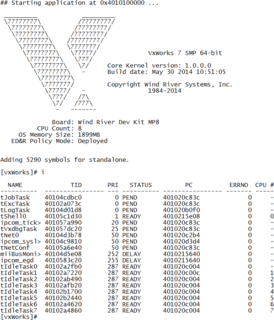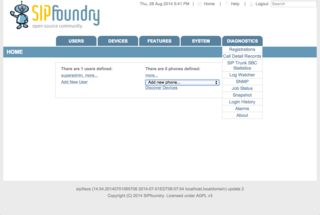Related Research Articles
Internet Small Computer Systems Interface or iSCSI is an Internet Protocol-based storage networking standard for linking data storage facilities. iSCSI provides block-level access to storage devices by carrying SCSI commands over a TCP/IP network. iSCSI facilitates data transfers over intranets and to manage storage over long distances. It can be used to transmit data over local area networks (LANs), wide area networks (WANs), or the Internet and can enable location-independent data storage and retrieval.

VxWorks is a real-time operating system developed as proprietary software by Wind River Systems, a wholly owned subsidiary of Aptiv. First released in 1987, VxWorks is designed for use in embedded systems requiring real-time, deterministic performance and, in many cases, safety and security certification, for industries, such as aerospace and defense, medical devices, industrial equipment, robotics, energy, transportation, network infrastructure, automotive, and consumer electronics.
Cisco Internetwork Operating System (IOS) is a family of network operating systems used on many Cisco Systems routers and current Cisco network switches. Earlier, Cisco switches ran CatOS. IOS is a package of routing, switching, internetworking and telecommunications functions integrated into a multitasking operating system. Although the IOS code base includes a cooperative multitasking kernel, most IOS features have been ported to other kernels such as QNX and Linux for use in Cisco products.
In software engineering, the terms frontend and backend refer to the separation of concerns between the presentation layer (frontend), and the data access layer (backend) of a piece of software, or the physical infrastructure or hardware. In the client–server model, the client is usually considered the frontend and the server is usually considered the backend, even when some presentation work is actually done on the server itself.

NetFlow is a feature that was introduced on Cisco routers around 1996 that provides the ability to collect IP network traffic as it enters or exits an interface. By analyzing the data provided by NetFlow, a network administrator can determine things such as the source and destination of traffic, class of service, and the causes of congestion. A typical flow monitoring setup consists of three main components:
A terminal server connects devices with a serial port to a local area network (LAN). Products marketed as terminal servers can be very simple devices that do not offer any security functionality, such as data encryption and user authentication. The primary application scenario is to enable serial devices to access network server applications, or vice versa, where security of the data on the LAN is not generally an issue. There are also many terminal servers on the market that have highly advanced security functionality to ensure that only qualified personnel can access various servers and that any data that is transmitted across the LAN, or over the Internet, is encrypted. Usually, companies that need a terminal server with these advanced functions want to remotely control, monitor, diagnose and troubleshoot equipment over a telecommunications network.

sipXecs is a free software enterprise communications system. It was initially developed as a proprietary voice over IP telephony server in 2003 by Pingtel Corporation in Boston, MA, and later extended with additional collaboration capabilities in the SIPfoundry project. Its core feature is a software implementation of the Session Initiation Protocol (SIP), which makes it an IP based communications system.

Nortel Meridian is a private branch exchange telephone switching system. It provides advanced voice features, data connectivity, LAN communications, computer telephony integration (CTI), and information services for communication applications ranging from 60 to 80,000 lines.
A service delivery platform (SDP) is a set of components that provides a service(s) delivery architecture for a type of service delivered to consumer, whether it be a customer or other system. Although it is commonly used in the context of telecommunications, it can apply to any system that provides a service. Although the TM Forum (TMF) is working on defining specifications in this area, there is no standard definition of SDP in industry and different players define its components, breadth, and depth in slightly different ways.
Multiservice Switch (MSS) is originally a Nortel line of routers, historically called Passport, designed for carrier core and edge routing. They run the Passport Carrier Release operating system. The MSS has a significant installed base, with over 40,000 switches sold.
InterSwitch Trunk (IST) is one or more parallel point-to-point links that connect two switches together to create a single logical switch. The IST allows the two switches to share addressing information, forwarding tables, and state information, permitting rapid fault detection and forwarding path modification. The link may have different names depending on the vendor. For example, Brocade calls this an Inter-Chassis Link (ICL). Cisco calls this a VSL.

The Avaya Ethernet Routing Switch 8600 or ERS 8600, previously known as the Passport 8600 or the Accelar 8000, is a modular chassis combination hardware router and switch used in computer networking. The system, originally designed and manufactured by Nortel, was manufactured by Avaya from 2009 until 2017. The system provided the 10G Ethernet equipment backbone for the 2010 Winter Olympics games, providing service for 15,000 VoIP Phones, 40,000 Ethernet connections and supporting 1.8 million live spectators. The system is configurable as a 1.440 Terabit Switch cluster using SMLT and R-SMLT protocols, to provide high reliability cluster failover.
Unified communications (UC) is a business and marketing concept describing the integration of enterprise communication services such as instant messaging (chat), presence information, voice, mobility features, audio, web & video conferencing, fixed-mobile convergence (FMC), desktop sharing, data sharing, call control and speech recognition with non-real-time communication services such as unified messaging. UC is not necessarily a single product, but a set of products that provides a consistent unified user interface and user experience across multiple devices and media types.

Ericsson-LG is a joint venture company owned by the Swedish group Ericsson (75%) and the South Korean group LG Electronics (25%). Founded in November 2005, it engineers and designs telecommunications equipment, with LG providing distribution and marketing. The company, which has approximately 1,500 employees, designs and markets advanced solutions for telecommunications networks operators and enterprises in Korea and internationally. On 29 June 2010, Ericsson bought Nortel's stake in LG-Nortel, and subsequently renamed it LG-Ericsson. On 22 March 2012, Ericsson raised its stake to 75%. On 10 April 2012, LG-Ericsson appointed Martin Wiktorin as CEO. On 1 Sep 2012, LG-Ericsson changed its name to Ericsson-LG.
Network Systems Corporation (NSC) was an early manufacturer of high-performance computer networking products. Founded in 1974, NSC produced hardware products that connected IBM and Control Data Corporation (CDC) mainframe computers to peripherals at remote locations. NSC also developed and commercialized the HYPERchannel networking system and protocol standards, adopted by Cray Research, Tektronix and others. In the late 1980s, NSC extended HYPERchannel to support the TCP/IP networking protocol and released a product allowing HYPERchannel devices to connect to the emerging Internet.

The Juniper MX-Series is a family of ethernet routers and switches designed and manufactured by Juniper Networks. In 2006, Juniper released the first of the MX-series, the MX960, MX240, and MX480. The second generation routers, called MX "3D", were first released in 2009 and featured a new Trio chipset and IPv6 support. In 2013, the MX routers were improved to increase their bandwidth, and a virtualized MX 3D router, the vMX 3D, was released in 2014. Utilizing the Juniper Extension Toolkit (JET), third party software can be integrated into the routers.

Avaya Virtual Services Platform 9000 Series or VSP 9000 is a set of modular chassis switches used in enterprise and data center networks, manufactured by Avaya. The VSP 9000 is used by institutions which are suffering from performance limitations, need to simplify their network infrastructure in a virtualized environment, or require 10 Gigabit Ethernet today with the option to scale to 40 or 100 Gigabit Ethernet in the future. It is also an option for companies who are looking to reduce the power and cooling cost in order to maximize the cost-effectiveness of their infrastructures; this unit was also designed and is expected to have a lifespan of seven-to-ten years. In 2013 the Olympics network backbone is built with VSP 9000 Switches supporting 30,000 users and up to 54 terabits per second of traffic.

Ethernet Routing Switch 3500 series and Ethernet Routing Switch 2500 series or ERS 3500 and ERS 2500 in data computer networking terms are stackable routing switches designed and manufactured by Avaya.
References
- ↑ "Networks". 12 November 2018.